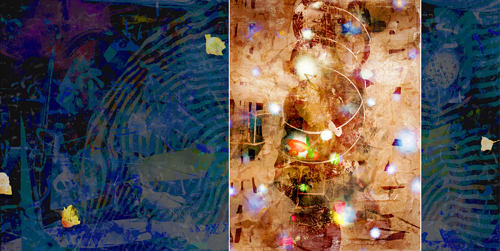
October Exhibition News(Click Here!) Mixture of Analog Painting & Digital ProductionThursday, October 5th Reception: Friday, October 6th, 5:00-7:30PM Gallery Hours
|
 |
|---|
Takayoshi Ueda “Fusion” NYCoo Gallery is pleased to announce Takayoshi Ueda's One-Man Show for the month of October entitled "Fusion and Mixture of Analog Painting and Digital Production." This show includes Ueda's representative works since 2003 making it possible to clearly see the artist's approach and attitude in his quest for new possibilities. The title of the show explains Ueda's rational, but a question arises: what is "Analog Painting?" What could it mean? In Japan, the word "digital" became popularized in the '80s with what came to be known as digital watches indicating time with numerals as opposed to watches with dials and arms which came to be called "analog watches" pronounced in Japanese "anarogu uocchi." The computer era has since emerged and the generation including Ueda who grew up with the culture of cyberspace calls hand-painted paintings "analog painting" or "anarogu peintengu." This expression may not exist in English. However, can the terminology "analog painting" be applied to all the paintings in history? The term has validity only when it is used by those who think and dwell in cyberspace who rediscover the tactile aspects of hand painting which exists in a world diametrically opposite theirs. Here, Ueda believes that the possibilities of new imagemaking exist in the fusion and mixture of the two and establishes it as the core issue in his studio practice. Takayoshi Ueda graduated from Seika University in Kyoto majoring in western-style painting, and works and resides in Wakayama Prefecture in Japan. Around 1995, a few years after his graduation, he began to use the computer as a tool for his paintings which gave him the direction for the way he works in his studio today. He has had a number of one-man shows and participated in group shows including the "NYCoo Gallery Fall Exhibition of 2004" in which he won the Digital Award and the "Group Coo Exhibition of 2005" at the same gallery. This is his first one-man show in New York. Ueda begins his work process by making drawings, collages, and construction of 3D structures with which he creates scanned images. These two stages, the tactile work and the digitization of the images by scanning, are repeated as many times as he feels necessary. Through the use of Photoshop, these images become so flexible that they can be juxtaposed, layered, eliminated, and interactivated instantaneously. This process takes the artist to new territories. After the images reach a satisfactory level with a desired impact, they are printed out on to canvas, printmaking paper, or Japanese paper with archival jet ink. Several of these printed images are then laid out to form a rectangle with thin spaces between the images for the final configuration of the work. The works on canvas are attached to a panel and varnished with polymer resin. Ueda calls this series of works "Plural Composition Work." In viewing his works, the juxtaposition of different colors from different sections stand out at first suggesting infinitely deep spaces, and then the specific textures for each different section become noticeable. The thin spaces between sections gives geometric structure to the work which the artist explains comes from fusuma-e, room divider, and byoubu-e, folding screen. He claims that the image consisting of multiple sections with the thin spaces in between gives a strong sense of existence that can not be achieved with a single image work. How will the viewer respond to Ueda's works with the idea of multiple images coexisting within? Also, could the polymer application compensate for the physical sense of existence that is lacking in the digital production and add to the presence of the final product? The pictorial plane with its multiple images is considered a reflection of contemporary society with its multicultural aspects and standards in general, and at the same time it is a direct influence of Post Modernist eclecticism. The effect of the polymer resin application is a point of interest which needs to be seen at the opening of the show. When new ideas are explored, realization of many issues jump out to be solved which provide more reasons for excitement.
|
Gallery writer : Hitoshi Nakazato
|
TAKAYOSHI UEDA |